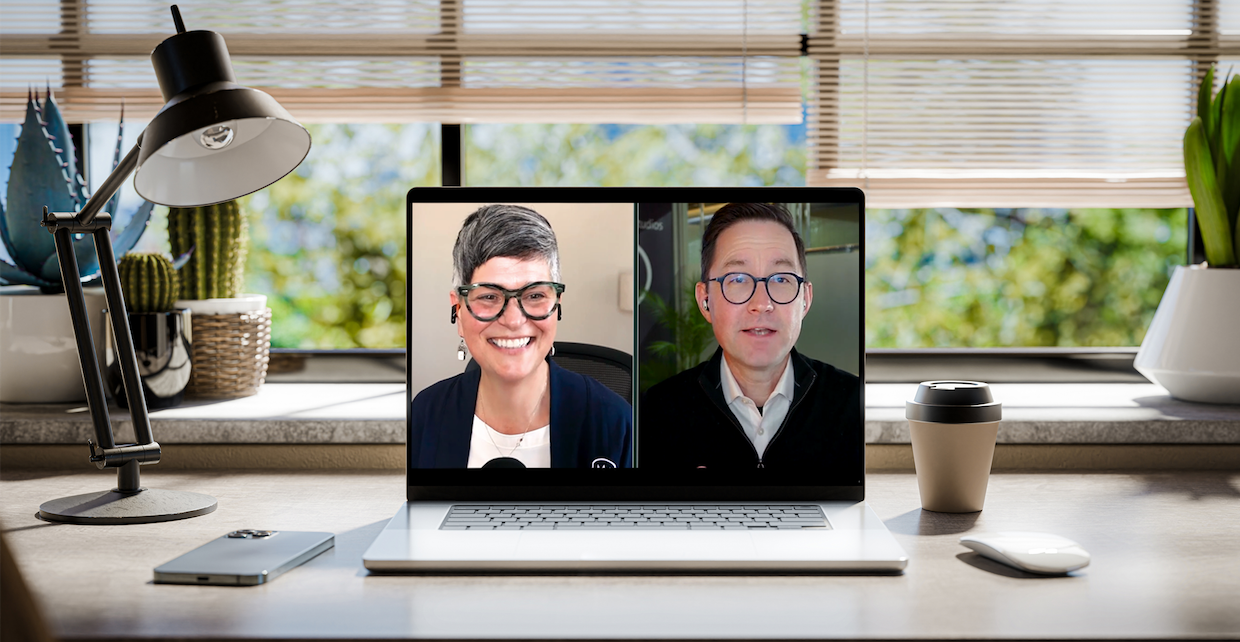How to Evolve Your Website from Traffic Magnet to Conversion Powerhouse
Written by
The most effective industrial marketers are those who can adapt quickly to change. In the context of today’s digital marketing landscape, the ability to stay agile and respond proactively to new trends is crucial — particularly amid today’s upheaval across marketing ecosystems. Staying ahead of the curve demands that marketers embrace change and rethink their digital strategies, starting with one of their most important owned assets — the company's website.
Dare I say it: Gone are the days when B2B websites could reliably serve as both top-of-funnel brand awareness generators and bottom-of-funnel conversion tools.
In an eye-opening episode of The ChangeOver Podcast, Greg Linnemanstons and I review and discuss the current user, search engine, technology, and market dynamics reshaping industrial website strategies. We unpack the new realities facing industrial marketers and salespeople, and recommend steps to make now to adapt and thrive in this new environment.
Looking ahead, successful marketers’ ability to pivot and innovate will be their greatest asset.
Today, a website acts more like a welcome mat to your organization, where visitors come when they’re already brand aware — likely in the middle, or even near the end, of their buying journey.
As our friend Peter Caputa of Databox put it to me recently, "Googling you is just the last thing they did before they got to your website." That means it’s time to rethink everything from the content we create to how we design the user experience.
Listen to the the full conversation in episode two of The ChangeOver Podcast below — and subscribe on Apple, YouTube, Spotify, Weidert.com, or your favorite podcast app.
Your Website Isn’t Dead — But It Does Need a New Job Description
When I first started in my career, an industrial company’s website was basically a digital brochure — static, company-centric, and not particularly interactive. Then, as inbound marketing took off in the 2010s, websites became our most powerful lead generation tools. They were built to attract, engage, and convert prospects with content that showcased your company’s expertise and aligned with what Google wanted to see.
But for many reasons (search algorithms, AI, volume of content and competition among them) that approach is no longer working well.
The days when your website could serve as a full-funnel asset — driving both top-of-the-funnel awareness and bottom-of-the-funnel conversions — are gone.
Today, most visitors arrive at your site already aware of your brand, often because they’ve encountered you through top-of-the-funnel tactics like earned media, paid advertising, social media, online communities, or even AI platforms like ChatGPT or Claude.
So, what’s the website’s role today? We said years ago that your website serves as a 24/7 sales guide, and that’s still true. But instead of trying to attract anyone from anywhere who could potentially buy your products/services, the emphasis needs to shift toward being an empathetic guide to your visitors and convert them to customers at higher rates than you are today. Remember, these are people who are already aware of your brand and actively considering their options, so having the shortest distance between SEO and UX is the goal. That means having a revenue-based SEO strategy (more on that in episode 3 of The ChangeOver so check that out too!) and pages on your site that match the intent of that searcher to quickly demonstrate your value to them and make it easy for them to take the next step in the buying journey. Speaking of buying journeys...
A More Fragmented, Less Predictable Buyer Journey
As technology proliferates, buyers’ journeys are increasingly fragmented. People aren’t just going to your website — or straight to Google with a query — to find answers to their challenges or questions. They’re searching in a million different online places, like AI tools, niche communities on Slack or Reddit, highly regarded trade sites, and more. And they’re consuming content in ways we might not have imagined a decade ago (YouTube Shorts, anyone?).
All that off-site research means that typically, when buyers come to your website, they’re often already in the middle or at the bottom of the funnel. They’re looking for specific solutions, vetting your brand, and figuring out whether you’re the right fit for them.
Users’ access to a wider variety of information sources, along with changes in the way search engines serve up SERPs (think AI Overviews) means they’re not as willing to exchange contact information for gated content like they used to.
That presents a new challenge for marketers, but with every challenge comes new opportunity — and today’s digital fragmentation creates a huge opportunity to rethink the value of the website, and how to use it to engage and convert visitors.
Rethinking Website Strategy: Focus on UX, Intent & Real Value
The industrial buying process, at the same time, has become increasingly complex and nonlinear — and often, the more expensive and highly-considered a purchase, the greater the complexity (and headcount on the purchasing team). Decision-makers are using a multitude of channels and resources long before they land on your website.
Here are several targeted approaches we discussed in the episode to help optimize your site for those MOFU-to-BOFU visitors and guide them toward a well-informed purchase decision:
- Target High-Intent Keywords. The days of casting a wide net with broad, educational keywords are over. Instead, focus on middle-to-bottom-of-the-funnel keywords that align with buying intent. You don’t need all the traffic when you’re focused on the needs of the people who are demonstrating intent that is likely to deliver revenue for you (or one of your competitors)
- Optimize for User Experience (UX). If visitors are coming to your site with a clear intent, make it as easy as possible for them to find what they’re looking for and take the next step. That means clear navigation, compelling calls to action, and content that guides them through the decision-making process without roadblocks
- Create Valuable Content, and Ungate It. Gated content simply doesn’t convert users like it once did. Instead, think about offering valuable content that provides immediate answers and insights, in a variety of mediums to meet different users’ needs and interests, from checklists to video to interactive tools. The goal is to create a path for conversion that feels natural and frictionless
- Build Trust Using Social Proof. Your website should reinforce your credibility at every step. Incorporate testimonials, case studies, and other forms of social proof that demonstrate you’re a trusted partner in solving the problems your visitors are looking for answers to
Building content that meets these four objectives is how you create a revenue-driven website.
Content Strategy: Quality & Humanity Over Quantity
The days of churning out high volumes of top-of-funnel content are well behind us. Large language models have evolved to the point where they can already do that, so they're cannibalizing educational content and the return is no longer there for content creators.. Today, B2B marketers should focus on creating highly valuable, human-centric, targeted content that addresses specific customer pain points and decision criteria for industrial buyers. Here are a few ideas to spark your own ideation:
- Interactive tools: ROI calculators, product configuration tools, and self-assessments can provide immediate value to visitors
- In-depth technical resources: comprehensive guides, video series, and whitepapers bolstered by primary research showcase expertise in solving complex industrial challenges
- Buyer’s guides: help prospective customers evaluate and compare options — both direct competitors and alternative solutions
While AI is reshaping content creation and search behavior, the industrial sector still heavily values human expertise and relationships. The key is to find the right balance, using AI to improve efficiency in data analysis and content creation, but ensure all output is reviewed, contextualized, and refined by human experts. And wherever possible, highlight the human element of your business through expert interviews, behind-the-scenes content, and personalized consultation offers. Leverage AI for initial inquiries, but provide clear UX pathways that make it easy to connect with human experts for more complex or technical conversations.
Rethinking Lead Generation for Industrial Markets
With gated content losing its lead capture effectiveness, what can marketers do to keep their pipeline full? First, think like your users. Then, consider how to implement new approaches:
- Offer value-first engagements. Instead of gating general information, offer one-to-one, human interactions that deliver value, like a free initial consultation, virtual product demo, or exclusive webinar.
- Progressive profile-building. Smart forms that remember returning visitors, and only ask for new, relevant information each time they engage, help reduce user fatigue and frustration.
- Chatbots with purpose. AI-powered chatbots can help answer FAQs, qualify leads, and schedule meetings with sales reps, saving users time and eliminating obstacles in their path toward a purchase.
Key Takeaway from the ChangeOver Podcast Episode 2: Evolve or Risk Obsolescence
Readers are well aware that the industrial marketing landscape has changed, and will continue to evolve fast — and website strategies need to evolve to meet it. By focusing on high-intent visitors, optimizing for their user experience, and providing valuable content they can’t get from other sources, you can transform your website from a passive information repository into a powerful conversion tool that drives real business results.
It all starts with a focus on what matters most: creating a website experience that’s built around the real needs of your audience, rather than chasing traffic metrics and expecting a predictable trickle-down from tangential topics to bottom-of-funnel interactions. And remember, your website is still one of your most valuable business assets — it’s just playing a different role than it did 5–10 years ago.
Dive deeper into these strategies and learn how to turn change into opportunity when you watch or listen to the full episode of The ChangeOver Podcast. Greg and I discuss all these points in detail and share practical tips and insights to help you stay on top, keep pushing forward, and make sure your website works as hard as you do.
Subscribe To Our Blog
Information. Insights. Ideas. Get notified every time a new Weidert Group blog article is published – subscribe now!
You May Also Like...

Artificial Intelligence
AI, Analytics & Content: Right-Now Strategies with Andy Crestodina

Artificial Intelligence
Revenue-Driving B2B Content Marketing Strategy with Andy Crestodina

Artificial Intelligence
AI Agents Are Here—How Smart Businesses Are Using Them Now
Accelerate Your Growth with
Weidert Group
If you’re ready to explore a partnership, request a personalized consultation with our team.

